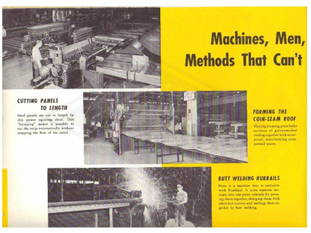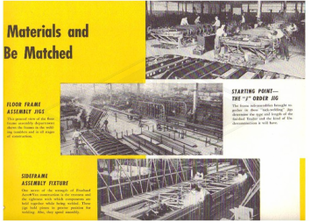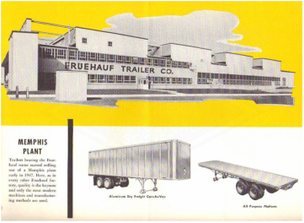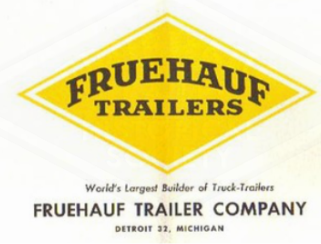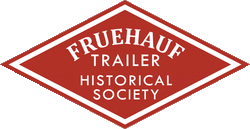Motor Transport
The Industry with the Big Future
The following is an address by Roy Fruehauf, President of Fruehauf Trailer Company, before the 8th National Credit Conference of the American Bankers Association in Chicago, Illinois, January 17, 1956. It was a speech made to further the progress of President Eisenhower’s national highway project, and in the interest of national defense.
What I plan to tell you concerning the future of motor transportation is based on sound reasoning, considerable research—and fine, sharp thinking of some really brilliant people from outside of our organization.
We in the motor transport industry—which today is America’s largest industrial employer—feel we have a real basis for confidence—some “Plain, plump facts,” as the poet, Browning, called them—which merit an optimistic view of the future.
Back about a hundred years the English statesman, Richard Cobden, said, “Great economic and social forces flow with a tidal sweep over communities that are only half conscious of that which is befalling them.”
Motor transport has come with a tremendous tidal sweep in the last ten years. In the ten years ahead—the “ten golden years” ahead as Philip D. Reed, General Electric’s board chairman, has labeled them—motor transport’s growth will be even more tremendous . . . even more engulfing than the growth of the last ten.
Motor transport got its modest start in the early 1900’s when an enterprising businessman removed the rear seat from a passenger automobile and replaced it with a box to hold packages.
It was some years later—in mid 1914—before another enterprising businessman walked into my father’s blacksmith shop in Detroit and presented my Dad with a problem. He said he had to haul a boat from Detroit to a lake in upper Michigan. The boat was much too long, he said, to be hauled in his Model T Ford. “What can you do!” he asked my Dad. No one is certain what Dad answered verbally—but the result of that request was the construction of the first Fruehauf trailer.
In 1914 there were 99,000 trucks registered in the 48 states. In 1928 this figure—which now included truck trailers—reached three million.
Motor transport has come with a tremendous tidal sweep in the last ten years. In the ten years ahead—the “ten golden years” ahead as Philip D. Reed, General Electric’s board chairman, has labeled them—motor transport’s growth will be even more tremendous . . . even more engulfing than the growth of the last ten.
Motor transport got its modest start in the early 1900’s when an enterprising businessman removed the rear seat from a passenger automobile and replaced it with a box to hold packages.
It was some years later—in mid 1914—before another enterprising businessman walked into my father’s blacksmith shop in Detroit and presented my Dad with a problem. He said he had to haul a boat from Detroit to a lake in upper Michigan. The boat was much too long, he said, to be hauled in his Model T Ford. “What can you do!” he asked my Dad. No one is certain what Dad answered verbally—but the result of that request was the construction of the first Fruehauf trailer.
In 1914 there were 99,000 trucks registered in the 48 states. In 1928 this figure—which now included truck trailers—reached three million.
Ten years later a total of 4 million trucks and trailers were on our highways. World War II gave trucking another tremendous boost because our armed forces were quick to seize upon this “go anywhere” type of transportation. Our company alone designed and built 125 different types of trailers for the men under arms.
By 1940 there were 5 million trucks and trailers in use. In the next 15 years’ time this total doubled. In 1955 10 million trucks and trailers carried the freight over our highways.
When the Interstate Commerce Commission started regulation of motor carriers and received its first reports from motor carriers for the year 1937, there were 54 trucking companies which had annual revenues of more than $1 million each. In 1955 there were nearly 900 motor carriers which reported to the Commission annual revenues of $1 million or more. This represents a phenomenal growth. That segment of the motor carrier industry which is not subject to economic regulation, such as private carriers and carriers of exempt commodities (agricultural commodities and others), has also expanded at an accelerated pace.
Motor carriers, both public or for-hire and private, transported 9 and 1/10 per cent of the intercity freight ton-miles in 1946. This increased to 19 and 1/10 per cent in 1954.
A recent advertisement of The First National City Bank of New York, under the headline “Trucks Triple Work-Load in Fifteen Years,” has excellently summarized the case for the trucking industry. Click for remainder of speech.....
By 1940 there were 5 million trucks and trailers in use. In the next 15 years’ time this total doubled. In 1955 10 million trucks and trailers carried the freight over our highways.
When the Interstate Commerce Commission started regulation of motor carriers and received its first reports from motor carriers for the year 1937, there were 54 trucking companies which had annual revenues of more than $1 million each. In 1955 there were nearly 900 motor carriers which reported to the Commission annual revenues of $1 million or more. This represents a phenomenal growth. That segment of the motor carrier industry which is not subject to economic regulation, such as private carriers and carriers of exempt commodities (agricultural commodities and others), has also expanded at an accelerated pace.
Motor carriers, both public or for-hire and private, transported 9 and 1/10 per cent of the intercity freight ton-miles in 1946. This increased to 19 and 1/10 per cent in 1954.
A recent advertisement of The First National City Bank of New York, under the headline “Trucks Triple Work-Load in Fifteen Years,” has excellently summarized the case for the trucking industry. Click for remainder of speech.....



